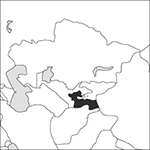
Source: MAPS IN MINUTES™ © RH Publications (1997)
Capital:
Dushanbe
Area:
143,100 sq km (55,240 sq miles)
Population:
7,910,041 (2013 est)
Currency:
1 somoni = 100 dirams
Religions:
Sunni Muslim 85.0%; Shia Muslim 5.0%
Ethnic Groups:
Tajik 79.9%; Uzbek 15.3%; Russian 1.1%; Kyrgyz 1.1%
Languages:
Tajik (official); Russian
International Organizations:
UN; OSCE; Commonwealth of Independent States; Euro‐Atlantic Partnership Council; WTO
A country bounded by China on the east and Afghanistan on the south; it occupies one of the highest regions of central Asia.
Physical
The Pamir mountains occupy a third of Tajikstan while the Alai range stretches across its centre. Below the snow‐line the slopes are generally great stretches of bare red and grey rocks, broken by alpine meadows.
Economy
Tajikstan is the poorest of the former Soviet republics, despite considerable mineral resources that include gold, silver, uranium, and tungsten. Almost half the workforce is engaged in agriculture. The principal industries are aluminium production and hydroelectricity, and the principal agricultural crop is cotton. These three commodities are major exports. Remittances from expatriates are important.
History
Tajiks were originally of Iranian stock, but were conquered by Arab people during the 7th and 8th centuries ad. Large numbers of Turkic people moved into the area, which came under the control of the Uzbek khanate of Bukhara from the 15th to the mid‐18th century and was then conquered by the Afghans. By 1868 the whole area had been conquered by the Russians and proclaimed a protectorate. Following the Russian Revolution a Bukharan People’s Soviet Republic was proclaimed in 1920. This however was conquered by the Red Army, and a confused situation lasted until 1929 when the Tajik Soviet Socialist Republic was formed, which in 1936 joined the Soviet Union. During 1990 opposition parties were legalized. In September 1991 independence was proclaimed and Tajikistan joined the Commonwealth of Independent States (CIS). By 1992, polarization between a nationwide Islamic majority and a Russian minority based in the capital Dushanbe and the industrialized north had developed. There were armed skirmishes, with Russian troops still stationed in the country becoming involved. In that year President Rakhmon Nabiyev was removed from office by force. Fighting between government forces and Muslim rebels was halted by a ceasefire in 1994, but sporadic violence continued. A new constitution was approved in 1994 and Imamoli Rakhmanov (now Emomali Rahmon), who had been acting head of state since 1992, was elected President. Legislative elections in 1995 resulted in victory for the ruling (formerly Communist) party. A further agreement with the rebels in 1997 led to constitutional changes and a reconciliation process. Rahmon, however, took steps to ensure he won the contested election in 1998. He has won all following elections; in 2013 he secured 84% of the vote and his rule remains authoritarian, with press censorship, patronage, and corruption endemic in his administration and in the major companies of Tajikistan.
- shift register
- shift-share analysis
- shift work
- Shi Huangdi (259–210)
- Shiites
- shikimic acid pathway
- Shimonoseki, Treaty of (17 April 1895)
- Shine-Dalgarno sequence
- shingle
- Shining Path
- Shinto
- Shipka
- Shipley, Jenny (1952)
- ship money
- ship of Theseus
- shire
- shit, geographies of
- Shivaji (1627–80)
- shivering
- Shlaer–Mellor
- SHM
- shoal
- shoaling
- shoal retreat massif
- shock